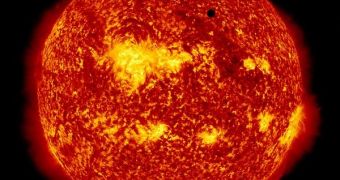Solar physicists at the Stanford University Wilcox Solar Observatory (WSO) say that the Sun will soon flip its polarity, a process that occurs over the course of a few months, once every 11 years.
The Sun operates in 11-year cycles, where periods of intense activity called solar maximums alternate with periods of calmness called solar minimums. During the former, numerous sunspots, coronal mass ejections and solar flares cloud the face of the Sun. During the latter, such phenomena occur only rarely.
Over the past couple of years, the level of activity displayed by the star has continuously increased. The last 2 weeks saw a large number of intense solar flares being released from the coronosphere, and the trend is very likely to continue until the star's magnetic poles change.
According to recent measurements, the magnetic polarity of the Sun's northern hemisphere has already changed. WSO investigators say that the process will soon occur in the southern hemisphere as well, and add that this event will cause ripples detectable in the farthest reaches of the solar system.
“The sun's poles are reversing, and this is a large-scale process that takes place over a few months, but it happens once every 11 years,” explains WSO solar physicist Todd Hoeksema, adding that the Observatory has been studying how the solar magnetic field changes since 1975.
“What we're looking at is really a reversal of the whole heliosphere, everything from the sun out past the planets,” he goes on to say, quoted by Space. Magnetic reversals affect us on Earth, too, primarily through the fact that we get to see more cosmic rays.
Additionally, increased activity on the surface of the Sun can affect the magnetosphere, a layer of our atmosphere that protects us from the harmful effects of solar radiation and charged particles. GPS systems, power grids, transformers and other electronic devices are susceptible to influences from increased levels of solar activity.
“We also see the effects of this on other planets. Jupiter has storms, Saturn has auroras, and this is all driven by activity of the Sun,” Hoeksema adds. Even here on Earth, increased levels of solar activity lead to the formation of beautiful auroras.
The expected magnetic shift in the Sun's northern hemisphere is not expected to affect satellites or astronauts aboard the International Space Station, solar physicists agree.

 14 DAY TRIAL //
14 DAY TRIAL //